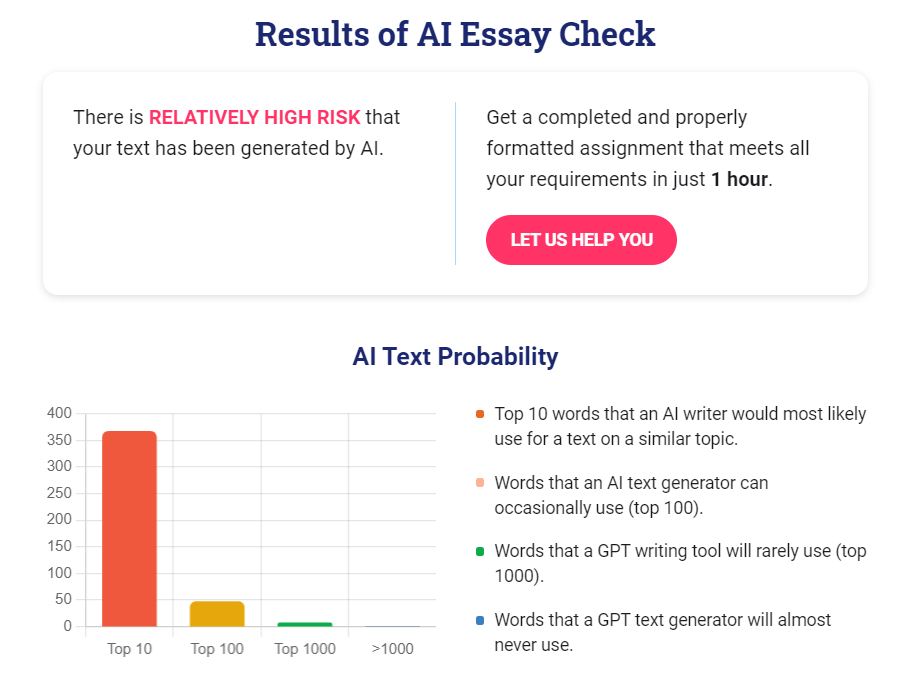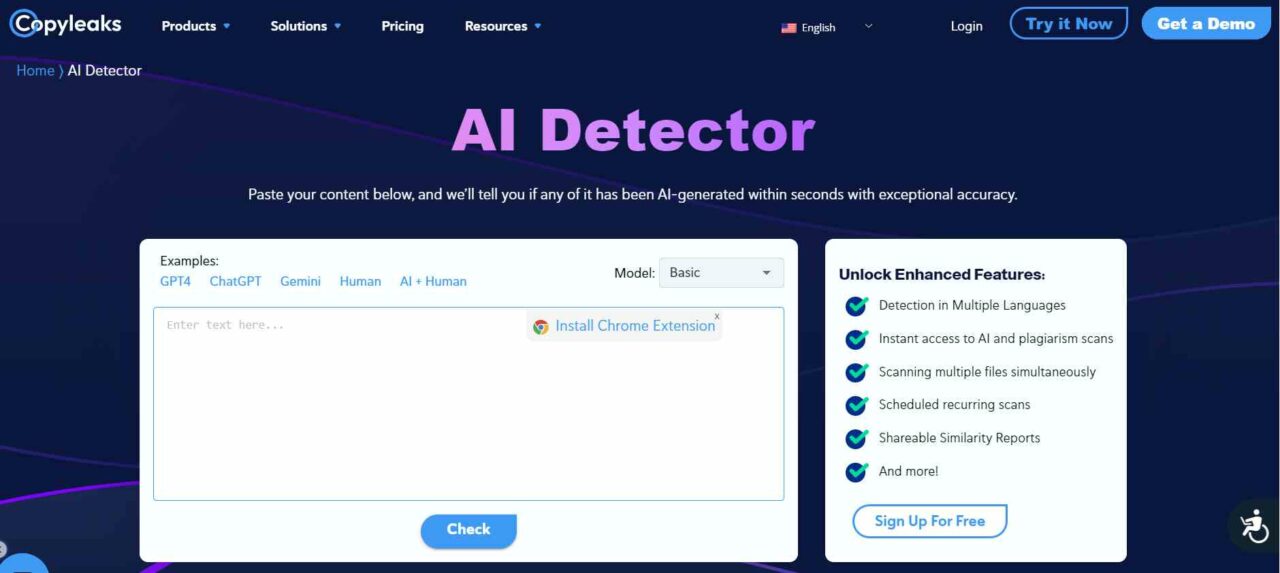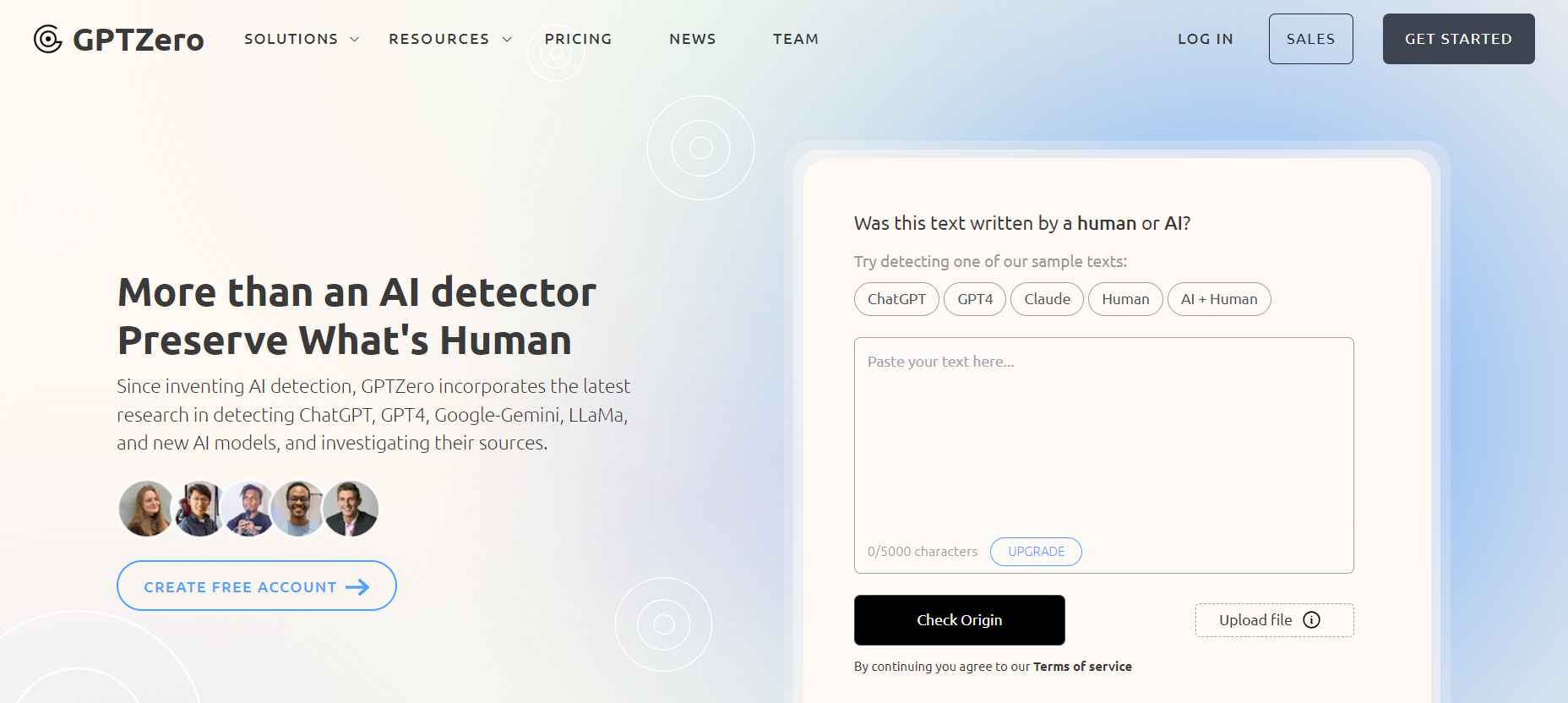In today’s academic world, the rise of AI-generated content has made it crucial for educators to ensure students are genuinely engaging with their work.
Knowing how to use AI tools to detect essays is essential not just for maintaining academic integrity, but for fostering genuine learning experiences.
The best AI tools have become increasingly sophisticated, using advanced algorithms to tell the difference between human and AI-generated text.
These tools can analyze writing patterns, language complexity, and stylistic consistency. Ready to detect AI-generated essays in the blink of an eye? Keep reading to find out how.
How to Use AI Tools to Detect Essays – Step-by-Step Guide
Understanding how to use AI tools to detect essays is crucial for educators aiming to maintain the authenticity of student submissions.
This step-by-step guide will walk you through the process of effectively utilizing these tools using “UniPapers” AI essay detection tool example:
Step 1: Paste the Writing Piece into the Text Box
Step 3: Interpret the Analysis
Step 1: Paste the Writing Piece into the Text Box
Copy the text of the essay or writing piece you want to analyze and paste it into the designated text box of the AI detection tool.

Step 2: Click “Detect”
After pasting the text, click the “Detect” button to start the analysis. The tool will begin examining the text for patterns and stylistic markers indicative of AI generation.

Step 3: Interpret the Analysis
Follow the prompts to understand the results:
- Conclusion: The tool will first provide a risk assessment, indicating whether there is a high, medium, or low likelihood that the text was AI-generated.
- AI Text Probability Chart: This chart shows the proportions of words categorized as often, occasionally, rarely, or almost never used by a GPT text generator.
- Detailed Text Analysis: The tool uses a color-coding system to highlight each word. By clicking on a word, you can see its top replacements that an AI text generator might use.

To simplify:
- If the text is likely AI-written, it will show mostly red with some yellow words.
- If the text is likely human-written, it will display many green and some blue words.

What are the key AI Tools to to Detect Essays?
Using AI tools to detect essays not only ensures originality but also enhances the overall quality of student submissions. Here are some of the most effective tools:
1. CopyLeaks
CopyLeaks is a leading AI detection checker that uses advanced algorithms to identify whether essays or other written content were created by AI tools like ChatGPT, Jasper, or Claude.

Supporting multiple languages, including French, German, Portuguese, Spanish, and English, CopyLeaks is easy to use: just copy and paste the text to get results in seconds.
The free version allows you to check up to 250,000 words, and a paid subscription adds an AI plagiarism and AI essay checker.
2. Winston AI
Winston AI, designed for educators, detects whether a document was written by a human with 99.6% accuracy. It uses Optical Character Recognition (OCR) technology to read handwriting, making it great for younger students’ handwritten work.

Available in English and French, Winston AI provides detailed reports explaining why content is flagged as AI-generated.
The paid version also offers a human score, a plagiarism detector, and a grade-level readability score, helping teachers identify inconsistencies in student submissions.
3. Content at Scale
Content at Scale offers an AI detector that identifies AI-generated content with 98.3% accuracy.
It supports multiple languages but can only handle 25,000 characters at a time, making it useful for essays but not longer texts.

While it lacks a plagiarism detector and content scanning capabilities, its free version is a valuable tool for educators on a budget.
4. GPTZero (and GPTZeroX)
GPTZero, designed specifically as a ChatGPT detector, focuses on textual complexity, sentence length, and variation, achieving 98% accuracy.
It analyzes potential AI influence at the sentence, paragraph, and document levels.

GPTZeroX, a paid version for educators, allows batch inputs, enabling teachers to upload multiple files simultaneously. Despite its speed and efficiency, it does not include a plagiarism detector.
What are the Approaches while Detecting AI Essays?
Understanding the various approaches to detecting AI-written essays can help maintain fairness in the education system. Here are some effective methods on how to use AI tools to detect essays.
1. Fighting Fire with Fire: AI vs. AI
Imagine using a special program to outsmart another program. That’s the idea behind AI detection tools.
These programs analyze the writing style and patterns to see if it matches the kind of text typically churned out by AI bots.
However, these tools work outside of your usual grading system and might not give you all the details behind how they reached their conclusions.
2. Who’s the Real Author? Analyzing Writing Habits
This approach flips the script. Instead of looking for robot giveaways, we can focus on the student’s own writing style.
By feeding the program a bunch of past essays known to be written by the student, we create a kind of writing fingerprint.
If there are big differences in vocabulary, sentence structure, or overall tone, it might be a sign that someone (or something) else wrote the essay.
3. Outsmarting the Machines: Personalized Assignments
Here’s a way to get ahead of the AI game altogether. Design assignments that are tough for robots to handle. AI bots can only write about what they’ve been trained on, which is usually publicly available information.
So, why not create assignments that draw on specific details from your class discussions, unique sources not readily found online, or the student’s own experiences?
However, it might take a little more effort to design these tasks, and they might not be foolproof if a student is struggling with writing on their own.
What to look for While Detecting AI-Generated Text?
When examining text for signs of AI generation, understanding key indicators can be crucial.
Here’s what to look for while detecting AI-generated text when learning how to use AI tools to detect essays:
- Unnatural Fluency: AI can sometimes produce grammatically correct sentences that sound odd or overly complex, especially when combining styles.
- Missing the Personal Touch: AI writing often lacks personal anecdotes or emotional depth, giving it a robotic feel.
- Repetitive Lingo: Be mindful of repeated phrases or vocabulary, a sign the AI is filling space with familiar terms.
- Outdated Information: If the text doesn’t reference current events or makes inaccurate claims, it might be pre-internet AI or poorly trained.
- Shallow Analysis: AI can struggle with complex analysis, so essays lacking original insights or critical thinking might be AI-generated.
- Inaccurate Details: AI might fabricate data or quotes to fill gaps in its knowledge. Check for inconsistencies between the text and cited sources.
- Uniform Structure: AI writing might lack the varied sentence structure and creative flow found in human writing.
- Style Shifts: Compare the essay to the student’s past work. Significant changes in vocabulary, sentence structure, or tone could indicate AI use.
- Unfamiliarity with Content: Ask the student to explain key points or their reasoning. Difficulty answering suggests they have used an AI essay writer.
- Strange Paraphrases: Tools used to rewrite essays can produce nonsensical phrases – another red flag.
For a more comprehensive guide on analyzing essays and other texts for AI involvement, learn about fact-checking AI-generated content.
What are the Best Practices for Educators in AI detection?
Implementing best practices for AI detection is crucial for maintaining academic integrity. Here are some effective strategies for educators on how to use AI tools to detect essays.
1. Avoid the AI Arms Race:
Recognize that your students are naturally curious and often ahead of the curve. Instead of trying to outsmart AI, focus on understanding and integrating it into your teaching strategies.
2. Encourage Comparison and Discussion:
Engage students in comparing their own work with AI-generated content. Discuss elements like claims, evidence, and reasoning to help them understand the differences.
Keep an open dialogue as you explore these distinctions together.
3. Explore AI with Curiosity:
Experiment with AI creatively for personal tasks or to draft initial ideas. Use it to refine your work and gain insights into how AI can assist with writing and editing.
4. Integrate AI into Classroom Activities:
Use AI to generate examples for your lessons. Input prompts into tools like ChatGPT or Bard to create drafts. These can serve as valuable teaching aids, allowing students to analyze and critique AI responses.
5. Foster Transparency and Collaboration:
Establish a transparent relationship with AI in the classroom. Set clear boundaries using a green, yellow, and red light strategy to guide when and how AI can be used.
Promote discussions on the appropriate use of AI for various activities.
How do AI writing detectors work?
Find out how does AI detection works while effectively learning how to use AI tools to detect essays and maintaining academic integrity:
Based on Language Models: AI detectors use similar language models to those in AI writing tools. They analyze the text and determine if it matches the patterns of AI-generated content. Furthermore, understanding the nuances of humanizing AI-generated text can enhance the effectiveness of these detectors by providing insights into distinguishing between human and AI-generated texts.
1. Perplexity and Burstiness:
- Perplexity: Measures how unpredictable a text is. Lower perplexity means the text is predictable and likely AI-generated. Human writing has higher perplexity due to creative choices and occasional typos.
- Burstiness: Looks at the variation in sentence structure and length. AI-generated text has low burstiness, with more uniform sentence lengths and structures. Human writing varies more, making it feel more natural.
Perplexity Levels:
- Low: “I couldn’t get to sleep last night.” (Most likely continuation)
- Medium: “I couldn’t get to sleep last time I drank coffee in the evening.” (Makes sense but less common)
- High: “I couldn’t get to sleep last pleased to meet you.” (Grammatically incorrect and illogical)
2. Watermarking:
OpenAI is working on a watermarking system for AI-generated text. This invisible watermark would help detect AI content, though it’s still under development and details are unclear.
3. Check for Common Mistakes:
Advanced grammar checkers spot common errors that AI might miss. This can help identify AI-generated content.
What are the Future Trends in AI Content Detection?
As AI continues to evolve, detecting AI-generated content becomes increasingly important for maintaining academic integrity.
Understanding how to use AI tools to detect essays and recognizing these future trends can help educators stay ahead in this technological race:
- Advancements in AI and Detection Technologies: AI algorithms are getting smarter and faster, making it easier to spot AI-generated content with high accuracy.
- New AI-Generated Content: As AI continues to advance, it will produce more sophisticated content, requiring even more advanced detection tools.
- Changing Ethical and Educational Standards: Schools and universities are setting stricter guidelines and ethical standards to manage the use of AI in academics.
- Integration with Learning Platforms: AI detection tools will be built into popular educational platforms, helping teachers easily identify AI-generated essays.
- Real-Time Detection: Future tools will offer instant analysis, providing immediate feedback on whether content is AI-generated.
- Better Natural Language Processing (NLP): Advances in Natural Language Processing (NLP) will allow tools to better understand and detect AI-created texts, even as they become more human-like.
- Collaborative Databases: Schools and tech companies will work together to create large databases of known AI-generated content, improving detection methods.
- User Behavior Analysis: Tools will analyze patterns like typing speed and style consistency to identify potential AI assistance.
- AI Self-Identification: Future Artificial Intelligence systems might be designed to self-identify when they have been used in content creation, adding transparency.
- Continuous Improvement: Detection tools will keep learning and improving based on new data and emerging AI writing techniques.
Explore More How-to Guides
For additional inspiration and practical advice, explore our how-to guides below:
- How to Use AI Tools for Predictive Maintenance in Manufacturing
- How to Use AI Tools to Detect Fraud in Financial Transactions
FAQs
Can Colleges Detect Essays Written by AI?
Is Using AI for Essays Cheating?
Is It Illegal to Use AI to Write an Essay?
How Can I Manually Identify AI-Generated Essays?
Wrap Up
Knowing how to use AI tools to detect essays is essential for maintaining academic standards and ensuring genuine student engagement. These tools provide educators with the means to identify AI-generated content accurately and efficiently.
AI-generated essays often exhibit overly perfect grammar, lack of personal anecdotes, and may miss subtle nuances in complex topics. However, not all AI applications diminish the learning experience; some, like using AI to proofread for grammar and clarity, can significantly enhance it by improving the quality of written assignments and communications.
Utilizing AI technologies helps create a more authentic and effective learning environment. Want to learn more about AI? Have a look at the AI glossary.





